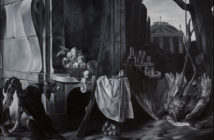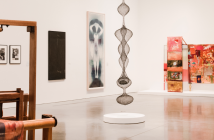Earlier this summer, Lisa Crossman sat on the grounds of the Old Manse in Concord, Massachusetts with Boston-based independent curator Pedro Alonzo. Alonzo is the Guest Curator for the Trustees Art and The Landscape initiative, which begins its program with Sam Durant’s The Meeting House at the Old Manse and Jeppe Hein’s A New End at the World’s End.
Alonzo’s served as an adjunct curator for other notable institutions such as the Institute of Contemporary Art, Boston and the Institute of Visual Arts at the University of Wisconsin–Milwaukee. Alonzo’s an expert on street art and has curated such public arts projects as Open Source in Philadelphia. He’s now an adjunct curator at the Dallas Contemporary.
In this conversation, Alonzo reflects on his past work and gives us a glimpse of the first two Art and The Landscape projects for the Trustees.
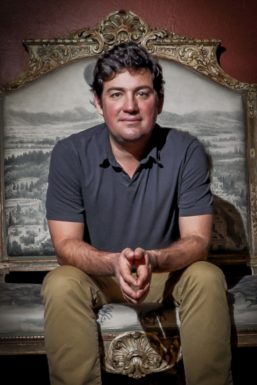
Pedro Alonzo
Lisa Crossman: Before we discuss your work with the Trustees, I thought it would be good to start off by talking about your curatorial work in general and your decision to remain an independent curator.
Pedro Alonzo: Sure. Early on I was very uncomfortable with the idea of being a curator and fought against it.
LC: Any particular reason?
PA: I was in college in Monterrey, Mexico, and I didn’t feel qualified to be a curator or even to think about being a curator. A museum of contemporary art [MARCO] had just opened and there were a lot of curators coming through like Dan Cameron and Walter Hopps. It was actually Walter Hopps, Victor Zamudio-Taylor (Ultra Baroque), and Peter Doroshenko who encouraged me to be in the arts. Victor very actively encouraged me, and he told me to do the summer internship at the MoMA. Walter wrote my letter of recommendation.
LC: That’s amazing.
PA: Yea – I wish I could find that letter.
LC: Ha! That’s one you should definitely keep.
PA: Right?! But I still didn’t feel qualified. As a student, I had worked for Arte Actual Mexicano, an art gallery in Monterrey. I was a token English speaker who would take American and European dealers and curators around. After MoMA, Peter Doroshenko asked me to curate a show for the university museum that he was running in Milwaukee called the Institute of Visual Arts (inova) [at the University of Wisconsin–Milwaukee]. And I was like, “no, I can’t curate something.” He said, “no, really you can curate something.” So I finally said, “well, okay, but don’t call me the curator.”
But then I did several shows. And I remember at an opening of Kerry James Marshall’s exhibition at The Renaissance Society, Madeline Grynsztejn–this must have been 1998–introduced me to two museum patrons as the Curator, Pedro Alonzo. I thought, oh my god, if she thinks I’m a curator, then I’m definitely a curator. That was when I embraced the title.
But I still felt self-conscious and awkward about it. You know I didn’t study art history. But regardless, I had started curating. And I became one of the adjunct curators at inova. Peter [Doroshenko, the Director] had a great program with Marilu Knode [Chief Curator] and a group of adjunct curators.
LC: Were you bringing in artists from Latin America?
PA: Exactly. And it created a really rich discussion. And the cool thing about Milwaukee is that no one has an agenda. It’s not like when you’re in New York, or even here in Boston. There was very little going on there. It made it close and tight.
LC: Is there a show that you did with inova that stands out as being particularly memorable?
PA: When I did the show with Marcos Ramírez “Erre”–his show opened with Pierre Huyghe–I met the woman who would become my wife.
LC: Well, that is certainly memorable.
PA: Yea – it is. She came out for Pierre and ended up with Pedro.
[Laughter]
LC: When did your interest in street art begin?
PA: It began in San Diego. I had a book distribution company from 1996-2007. I had started to distribute Yoshitomo Nara’s books published by the Tokyo-based publisher Little More. And then Takashi Murakami got wind of it and wanted me to distribute his books. I came at street art through Little More who published some of the first monographs on street artists. When I received the books, I looked at them. Even though I didn’t know who these artists were, their books sold really well. The museums sold through them like crazy. I found that to be really strange. But it was clear to me that I had a prejudice. I looked at street art and thought, this isn’t really art, but it sells well. And then I challenged myself and asked, why isn’t this art? I mean if anything can be art…It made me really think, why not this?
So I went out and started to meet the artists. The first ones I met were the FAILE guys. And then I met Ryan McGinness and Shepard Fairey…
LC: So let’s fast forward to the Shepard Fairey show at the ICA. That was the first street art project you worked on here in Boston, right?
PA: Yes, but I had already done a big street art exhibition in England [September 27, 2006-January 7, 2007]. It was the first international show. We had artists from all over the world. It was called Spank the Monkey. [laughter] I didn’t put the title on it.
LC: Well, I won’t forget that title.
PA: No one forgets that title [laughing]. Banksy was in it. Peter Doroshenko, the director of the museum [the BALTIC Centre for Contemporary Art], came up with the title. It was the first museum show for a lot of these artists. And they all [twenty artists total] hated the title.
LC: What were some of the challenges that you encountered in trying to translate their work from the street to the museum and also in making them feel comfortable?
PA: There’s a lot of nuance. First of all, it wasn’t strictly a street art show. The whole idea was that I didn’t want to create a ghetto. We wanted a dialogue with contemporary art. What we decided to do was kind of like Ultra Baroque, coming up with a theme that would encompass these artists, but looking at it from a different perspective. The idea was to look at artists with a multidisciplinary practice who were making work in the studio, in the street, but also t-shirts, prints, and products that lent the show to a bigger conversation. Takashi Murakami’s Louis Vuitton bags were in the show, for instance.
LC: So you were thinking about artists who were circulating their work in a broader network than the conventional art circuit?
PA: Yes. And it made sense as part of the show to have a robust outdoor component and to really integrate it into the fabric of the city.
The head of the subway system for the City of Newcastle, charged with graffiti control, came to see me on the first day. I was like, oh my god, I have to deal with this on my first day. And the guy was like “hey, great to meet you, I’m so excited about your show. It’s going to be awesome.”
And, I was like, “hold on, hold on, why are you excited and happy about this? This makes no sense.” The guy basically said that he had been cleaning up crap for twenty years, and that he had learned to appreciate street art and graffiti, and that we were bringing the heroes–the best of the best: Os Gemeos, Barry McGee, Shepard Fairey, FAILE. “Not only do I like what you’re doing, [he said], but it will help my budget.”
He said that because every wall that they [the artists] painted would be a sanctioned work and would not require cleaning. So he gave us access to any walls we wanted in the subway stations. It was nuts. There was crazy dialogue. These guys were so excited. They were up all night painting and then they’d go to the Museum and work, and then they’d be up all night painting. It was great!
But what was interesting was that pretty much everyone ignored the premise and the presence of everyone in the show except for the street artists. Even though it was probably the largest work David Shrigley has ever made–a huge banner on the side of the Museum–most people only paid attention to the street artists.
The variety was important, but what happened was that the street art world attacked it, asking how dare I put street art in a museum. And then the art establishment attacked it because how dare I put street art in a museum. There was this resentment that I had coopted the artists. And there were a lot of questions about whether this art that was made outside should be brought inside. And at the time, the term street art didn’t even exist. No one knew what to call it. I referred to it as urban art, and it was about its proximity to youth culture. One of the things that I thought was really interesting about it was the importance within the art world of an artist like Dan Graham who references youth culture but is not part of it. But if you look at Shepard Fairey, he helped define youth culture in the 1990s. I mean McGinnesss at the time, his aesthetic is what every surf brand wanted on its t-shirts and clothing. So boom–all these surf and skate brands had McGinness-inspired designs even though they wouldn’t credit him.
LC: How did you respond to the questioning of your showing street art in the museum? Or did it just fuel you to do more?
PA: It made me want to do more. I learned a lot. It made me want to be tighter with what I was saying. It made me want to do it better. There were some things that worked really well like making work outside. People loved seeing it. That’s the one thing that no one criticized…wait, some people said, well, it’s legal so it doesn’t count–as if saying that if the artist isn’t in danger of being arrested it isn’t valid. There were a lot of ridiculous preconceptions, and it was about battling those on both sides. But then there was the populace. It broke [attendance] records. People went to see it. People loved it. People were excited about it.
But what did I learn? I learned not to worry about what the media thought and to just do it and to be true to the artists and their intentions.
LC: Then with Shepard’s show at the ICA in 2009, what did you do differently that you saw as a success?
PA: With Shepard, I knew that we absolutely had to have outdoor work–a lot of it. We stayed away from making outdoor work indoor. Shepard has a robust studio practice that most people don’t know about it. Works on canvas and prints mostly were inside and his other work outside.
The goal with Shepard was to show the breadth of his work. Most people thought, oh, that’s the dude who did the sticker with André the Giant or oh, that’s the dude who did Obama. And I wanted to fill in the material between those bookends. That breadth was important for me to exhibit and to show it in the way that you would show any of his peers and to not distinguish him as a street artist.
His show marked a really interesting transformation because, by the time we got around to that show, there was no question that street art was an art form and that it could be in a museum.
LC: What has influenced your decision to remain an adjunct curator? How have you been able to get so many gigs?
PA: I think the dynamics of being an adjunct curator are pretty much the same. I kind of think of it as the best of both worlds.
I think the reason why I’m able to do independent and adjunct work is because I’m working outside of what a lot of my colleagues are doing. So it provides a lot of opportunity. And I don’t want to do what everyone else is doing. I really look at what others are doing and wonder why would I want to do what everyone else is doing in a different way with an art historical nuance. I’m interested in breaking out of molds.
LC: Which brings me to the next question. You’re working with the Trustees, which breaks from your focus on urban environments. You’re now focused on a very different type of space that is relatively undeveloped and more remote. The Trustees maintain unique sites and want to engage with not only conservation and the natural environment of these sites, but also their history and the social context of each place.
How has your work with street art shaped your approach to these sites? And would you tell me about your process for thinking about what work or artist should be selected for each site?
PA: Basically I’m responding to the sites. The Trustees gave me a series of sites, I went to visit them and brought my family–my kids, my wife, my parents, visiting friends and relatives–and we walked around and talked about each one and figured it out. I wanted to see where my kids would go, and to find out what my wife likes or doesn’t like about the sites, and that gives me a broader sense of what the site is about. I thought about what distinguishes each site and about the unique attributes of each site.
LC: How many sites did you look at? I know that there are two projects in the works now.
PA: I looked at six sites. And then I wrote down what I thought was unique and interesting about each site. Some are primarily summer sites and others are year round. Others are about natural beauty, still, others are about history, and some are about both. I mean it’s hard to think sitting here, at the Old Manse, that this site is all about history, but it is. It’s beautiful, but it’s really about history. So those attributes are what led me to pick the artists.
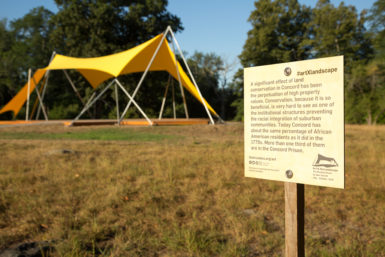
Sam Durant, The Meeting House, seen from interpretive sign, 2016. Photo by Alex Jones. Courtesy of The Trustees.
LC: There’s a lot of engagement with community planned for the Old Manse. How does the initiative’s interest in community influence your selection of artists? How do you weigh your consideration of international artists against local artists?
PA: This is a national historic landmark. Few artists have had access to sites of this historical relevance, particularly in this country. In Europe it’s different, but here it’s rare. I had to work with someone I could trust and I knew would be thoughtful and could work within an affluent community, answer the complicated questions that would arise. I needed someone who would face the issues, confront them, and deal with them. That’s why I thought of Sam [Durant]. He’s the one who came up with the idea of race. His project is really about responding to the site.The project here at Old Manse is outward looking and addresses big issues that are confronting our society at a historic location that’s very beautiful.
World’s End also has a lot of historical relevance. It was one of the original sites considered for the United Nations, and the grounds were designed by Frederick Olmsted. There’s a lot of history there for sure, but the history, in my opinion, is totally overshadowed by the beauty of the site. It’s a magnificent site on the South Shore. How do you compete with that? How do you have an impact within that environment? So you need someone who can make an impact under those conditions in that environment.
So with Jeppe [Hein], his piece is about presence and peace of mind. It’s a mirrored pavilion. It’s a thoughtful piece. I almost see it like going to yoga or meditating.
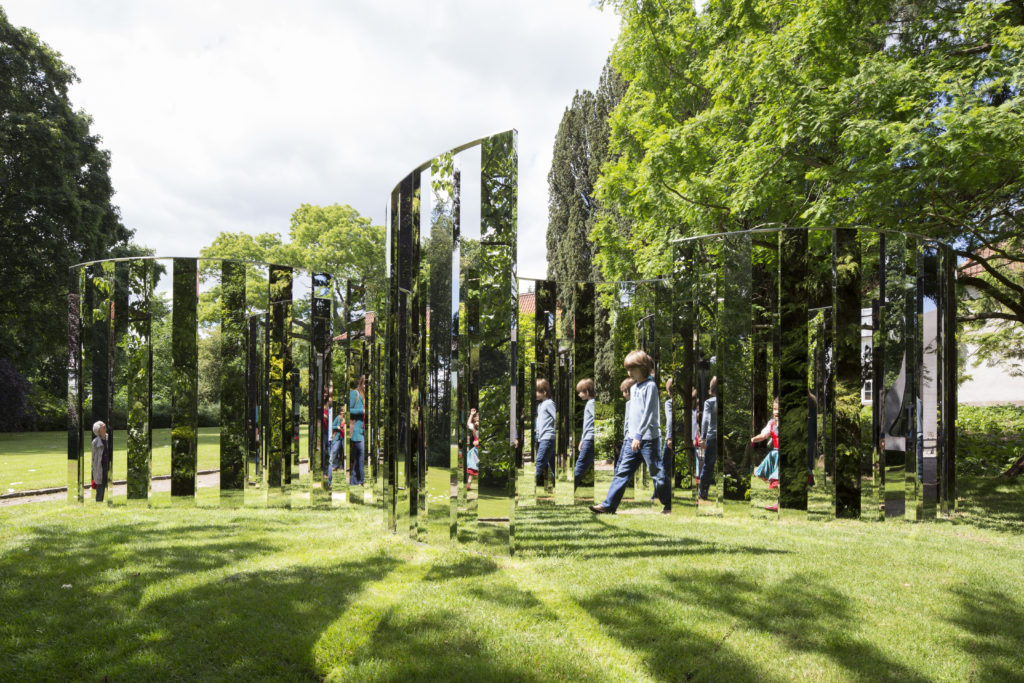
Jeppe Hein, Semicircular Mirror Labyrinth II, 2013. © Jeppe Hein, courtesy of 303 Gallery, New York, KÖNIG GALERIE, Berlin, and Galleri Nicolai Wallner, Copenhagen.
LC: So Hein’s piece is intended more for individual reflection whereas the one at Old Manse is about collective awareness?
PA: Yes – Jeppe's work is about individual wellness whereas Sam’s is about society–healing society, or at least opening a discussion. So they are very different, which is what I like about them.
LC: You mentioned an affluent audience, but I wonder if you have hopes to diversify the audience and a plan for how you might do this.
PA: Well the programming will definitely do this, and we’re working to get a variety of people out here as an integral part of it. We are collaborating with several organizations to get the public to the sites. We’re really trying to mix up the audience and to have a more balanced discussion. The thing about having the discussion here is that this is where a lot of the discussions led to the ideas that defined this country and the nation’s sense of self. We can’t have a dinner and have the discussions within the Old Manse, but we can have it next door. We’re going to have it between where the political revolution started and where the intellectual one began.
LC: To conclude, what’s next? It’s a multiyear project, but what does this mean? Are there other sites in the works?
PA: Yes, we will continue the program. Stay tuned.

